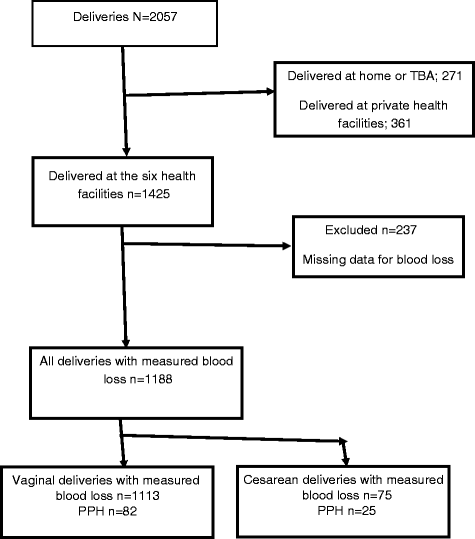Incidence and risk factors for postpartum hemorrhage in Uganda
- PMID: 27080710
- PMCID: PMC4832492
- DOI: 10.1186/s12978-016-0154-8
Incidence and risk factors for postpartum hemorrhage in Uganda
Abstract
Background: Globally, postpartum haemorrhage (PPH) remains a leading cause of maternal deaths. However in many low and middle income countries, there is scarcity of information on magnitude of and risk factors for PPH (blood loss of 500 ml or more). It is important to understand the relative contributions of different risk factors for PPH. We assessed the incidence of, and risk factors for postpartum hemorrhage among rural women in Uganda.
Methods: Between March 2013 and March 2014, a prospective cohort study was conducted at six health facilities in Uganda. Women were administered a questionnaire to ascertain risk factors for postpartum hemorrhage, defined as a blood loss of 500 mls or more, and assessed using a calibrated under-buttocks drape at childbirth. We constructed two separate multivariable logistic regression models for the variables associated with PPH. Model 1 included all deliveries (vaginal and cesarean sections). Model 2 analysis was restricted to vaginal deliveries. In both models, we adjusted for clustering at facility level.
Results: Among the 1188 women, the overall incidence of postpartum hemorrhage was 9.0%, (95% confidence interval [CI]: 7.5-10.6%) and of severe postpartum hemorrhage (1000 mls or more) was 1.2%, (95% CI 0.6-2.0%). Most (1157 [97.4%]) women received a uterotonic after childbirth for postpartum hemorrhage prophylaxis. Risk factors for postpartum hemorrhage among all deliveries (model 1) were: cesarean section delivery (adjusted odds ratio [aOR] 7.54; 95% CI 4.11-13.81); multiple pregnancy (aOR 2.26; 95% CI 0.58-8.79); foetal macrosomia ≥4000 g (aOR 2.18; 95% CI 1.11-4.29); and HIV positive sero-status (aOR 1.93; 95% CI 1.06-3.50). Risk factors among vaginal deliveries only, were similar in direction and magnitude as in model 1, namely: multiple pregnancy, (aOR 7.66; 95% CI 1.81-32.34); macrosomia, (aOR 2.14; 95% CI1.02-4.47); and HIV positive sero-status (aOR 2.26; 95% CI 1.20-4.25).
Conclusion: The incidence of postpartum hemorrhage was high in our setting despite use of uterotonics. The risk factors identified could be addressed by extra vigilance during labour and preparedness for PPH management in all women giving birth.
Keywords: Labor; Oxytocics; Postpartum hemorrhage; Pregnancy; Risk factors.
Similar articles
-
Incidence, risk factors, and temporal trends in severe postpartum hemorrhage.Am J Obstet Gynecol. 2013 Nov;209(5):449.e1-7. doi: 10.1016/j.ajog.2013.07.007. Epub 2013 Jul 16. Am J Obstet Gynecol. 2013. PMID: 23871950
-
Incidence and risk factors for postpartum hemorrhage among transvaginal deliveries at a tertiary perinatal medical facility in Japan.PLoS One. 2019 Jan 9;14(1):e0208873. doi: 10.1371/journal.pone.0208873. eCollection 2019. PLoS One. 2019. PMID: 30625154 Free PMC article.
-
Postpartum haemorrhage management, risks, and maternal outcomes: findings from the World Health Organization Multicountry Survey on Maternal and Newborn Health.BJOG. 2014 Mar;121 Suppl 1:5-13. doi: 10.1111/1471-0528.12636. BJOG. 2014. PMID: 24641530
-
Aetiology and treatment of severe postpartum haemorrhage.Dan Med J. 2018 Mar;65(3):B5444. Dan Med J. 2018. PMID: 29510809 Review.
-
Active management of the third stage of labour: prevention and treatment of postpartum hemorrhage.J Obstet Gynaecol Can. 2009 Oct;31(10):980-993. doi: 10.1016/S1701-2163(16)34329-8. J Obstet Gynaecol Can. 2009. PMID: 19941729 Review.
Cited by
-
Prevalence and risk factors of severe postpartum hemorrhage: a retrospective cohort study.BMC Pregnancy Childbirth. 2021 Apr 26;21(1):332. doi: 10.1186/s12884-021-03818-1. BMC Pregnancy Childbirth. 2021. PMID: 33902475 Free PMC article.
-
Physiology and Pathology of Contractility of the Myometrium.In Vivo. 2021 May-Jun;35(3):1401-1408. doi: 10.21873/invivo.12392. Epub 2021 Apr 28. In Vivo. 2021. PMID: 33910817 Free PMC article. Review.
-
FairEmbo Concept for Postpartum Hemorrhage: Evaluation of the Efficacy of Suture Fragment Compared with Gelatin Sponge Torpedo Embolization in a Post-Gravid Swine Model.J Pers Med. 2023 Jan 7;13(1):124. doi: 10.3390/jpm13010124. J Pers Med. 2023. PMID: 36675785 Free PMC article.
-
Trends and patterns of maternal deaths from 2015 to 2019, associated factors and pregnancy outcomes in rural Lagos, Nigeria: a cross-sectional study.Pan Afr Med J. 2023 Apr 20;44:185. doi: 10.11604/pamj.2023.44.185.37567. eCollection 2023. Pan Afr Med J. 2023. PMID: 37484584 Free PMC article.
-
Risk Factors for Postpartum Hemorrhage and its Severe Forms with Blood Loss Evaluated Objectively - A Prospective Cohort Study.Rev Bras Ginecol Obstet. 2021 Feb;43(2):113-118. doi: 10.1055/s-0040-1718439. Epub 2021 Jan 28. Rev Bras Ginecol Obstet. 2021. PMID: 33511619 Free PMC article.
References
-
- Sheldon WR, Blum J, Vogel JP, Souza JP, Gulmezoglu AM, Winikoff B, Maternal WHOMSo. Newborn Health Research N Postpartum haemorrhage management, risks, and maternal outcomes: findings from the World Health Organization Multicountry Survey on Maternal and Newborn Health. BJOG. 2014;121(Suppl 1):5–13. doi: 10.1111/1471-0528.12636. - DOI - PubMed
-
- Road map for accelerating reduction in maternal and neonatal mortality and morbidity in Uganda. [cited 20 March 2015]. Available at URL: http://www.nationalplanningcycles.org/sites/default/files/country_docs/U...
Publication types
MeSH terms
Substances
Grants and funding
LinkOut - more resources
Full Text Sources
Other Literature Sources
Medical


